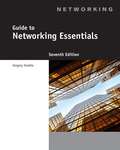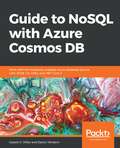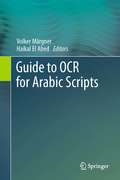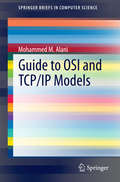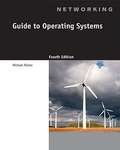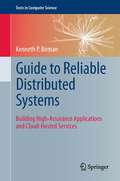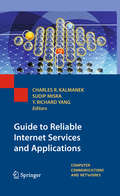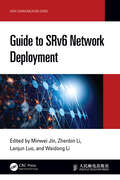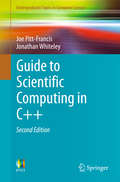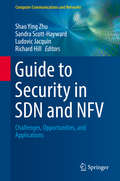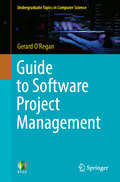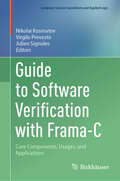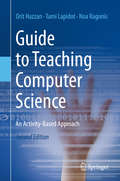- Table View
- List View
Guide to Networking Essentials
by Greg TomshoGUIDE TO NETWORKING ESSENTIALS provides students with both the knowledge and hands-on skills necessary to work with network operating systems in a network administration environment. By focusing on troubleshooting and computer networking technologies, this book offers a comprehensive introduction to networking and to advances in software, wireless and network security.
Guide to NoSQL with Azure Cosmos DB: Work with the massively scalable Azure database service with JSON, C#, LINQ, and .NET Core 2
by Gastón C. Hillar Daron YöndemCreate scalable applications by taking advantage of NoSQL document databases on the cloud with .NET CoreKey FeaturesWork with the latest available tools related to Cosmos DBLearn to work with the latest version of the .NET Core SDK, C# and the SQL APIWork with a database service that doesn’t require you to use an ORM and provides flexibilityBook DescriptionCosmos DB is a NoSQL database service included in Azure that is continuously adding new features and has quickly become one of the most innovative services found in Azure, targeting mission-critical applications at a global scale. This book starts off by showing you the main features of Cosmos DB, their supported NoSQL data models and the foundations of its scalable and distributed architecture. You will learn to work with the latest available tools that simplify your tasks with Cosmos DB and reduce development costs, such as the Data Explorer in the Azure portal, Microsoft Azure Storage Explorer, and the Cosmos DB Emulator.Next, move on to working with databases and document collections. We will use the tools to run schema agnostic queries against collections with the Cosmos DB SQL dialect and understand their results. Then, we will create a first version of an application that uses the latest .NET Core SDK to interact with Cosmos DB. Next, we will create a second version of the application that will take advantage of important features that the combination of C# and the .NET Core SDK provides, such as POCOs and LINQ queries. By the end of the book, you will be able to build an application that works with a Cosmos DB NoSQL document database with C#, the .NET Core SDK, LINQ, and JSON.What you will learnUnderstand the supported NoSQL data models and the resource hierarchyLearn the latest tools to work with Cosmos DB accounts and collectionsReduce your development costs by working with the Cosmos DB EmulatorUnderstand request units, automatic indexing, partitioning, and billingBuild an application with C#, Cosmos DB, .NET Core SDK, and the SQL APIPerform asynchronous operations with databases, and documents in C#Work with models, and customize serialization of LINQ queriesWho this book is forThis book is for C# developers. You do not require any knowledge of Azure Cosmos DB, but familiarity with the Azure platform is expected.
Guide to OCR for Arabic Scripts
by Volker Märgner Haikal El AbedThis Guide to OCR for Arabic Scripts is the first book of its kind, specifically devoted to this emerging field. Topics and features: contains contributions from the leading researchers in the field; with a Foreword by Professor Bente Maegaard of the University of Copenhagen; presents a detailed overview of Arabic character recognition technology, covering a range of different aspects of pre-processing and feature extraction; reviews a broad selection of varying approaches, including HMM-based methods and a recognition system based on multidimensional recurrent neural networks; examines the evaluation of Arabic script recognition systems, discussing data collection and annotation, benchmarking strategies, and handwriting recognition competitions; describes numerous applications of Arabic script recognition technology, from historical Arabic manuscripts to online Arabic recognition.
Guide to OCR for Indic Scripts
by Venu Govindaraju Srirangaraj Ranga SetlurThis unique guide/reference is the very first comprehensive book on the subject of OCR (Optical Character Recognition) for Indic scripts. Features: contains contributions from the leading researchers in the field; discusses data set creation for OCR development; describes OCR systems that cover 8 different scripts - Bangla, Devanagari, Gurmukhi, Gujarati, Kannada, Malayalam, Tamil, and Urdu (Perso-Arabic); explores the challenges of Indic script handwriting recognition in the online domain; examines the development of handwriting-based text input systems; describes ongoing work to increase access to Indian cultural heritage materials; provides a section on the enhancement of text and images obtained from historical Indic palm leaf manuscripts; investigates different techniques for word spotting in Indic scripts; reviews mono-lingual and cross-lingual information retrieval in Indic languages. This is an excellent reference for researchers and graduate students studying OCR technology and methodologies.
Guide to OSI and TCP/IP Models
by Mohammed M. AlaniThis work opens with an accessible introduction to computer networks, providing general definitions of commonly used terms in networking. This is followed by a detailed description of the OSI model, including the concepts of connection-oriented and connectionless communications. The text carefully elaborates the specific functions of each layer, along with what is expected of protocols operating at each layer. Next, the journey of a single packet, from source to destination, is described in detail. The final chapter is devoted to the TCP/IP model, beginning with a discussion of IP protocols and the supporting ARP, RARP and In ARP protocols. The work also discusses the TCP and UDP protocols operating at the transport layer and the application layer protocols HTTP, DNS, FTP, TFTP, SMTP, POP3 and Telnet. Important facts and definitions are highlighted in gray boxes found throughout the text.
Guide to Operating Systems (Fourth Edition)
by Michael Palmer Michael WaltersGet the latest theory and technical information for working on Windows, Mac OS, and UNIX/Linuxplatforms with GUIDE TO OPERATING SYSTEMS, 4E. Topics include operating system theory, installation, upgrading, configuring (operating system and hardware), file systems, security, hardware options, storage, resource sharing, network connectivity, maintenance, and troubleshooting. Designed to be easily understood and highly practical, GUIDE TO OPERATING SYSTEMS, 4E is the resource readers need for deepening their understanding of different operating systems. GUIDE TO OPERATING SYSTEMS, 4E prepares readers to understand the fundamental concepts of computer operating systems. The book specifically addresses Windows XP, Windows Vista, Windows 7, Windows Server 2003 and Windows Server 2003 R2, Windows Server 2008 and Windows Server 2008 R2, SUSE Linux, Fedora Linux, Red Hat Linux, and Mac OS X (Panther, Tiger, Leopard, and Snow Leopard), and provides information on all network operating subjects.
Guide to Operating Systems (Mindtap Course List Series)
by Greg TomshoMaster the fundamental concepts of computer operating systems with Tomsho's GUIDE TO OPERATING SYSTEMS, 6th Edition. An excellent resource for training across different operating systems, this practical text equips you with key theory and technical information as you work with today's most popular operating systems, including Windows, macOS and Linux platforms. You will learn how general operating systems are organized and function as well as gain hands-on experience with OS installation, upgrading and configuration. Processors, file systems, networking, virtualization, security, device management, storage, OS maintenance and troubleshooting are covered in detail. In addition, the MindTap digital learning solution gives you a wealth of anywhere, anytime learning resources.
Guide to Optimal Operational Risk and BASEL II
by Ioannis S. Akkizidis Vivianne BouchereauGuide to Optimal Operational Risk and Basel II presents the key aspects of operational risk management that are also aligned with the Basel II requirements. This volume provides detailed guidance for the design and implementation of an efficient operational risk management system. It contains all elements of assessment, including operational risk i
Guide to Pairing-Based Cryptography (Chapman & Hall/CRC Cryptography and Network Security Series)
by Nadia El Mrabet; Marc JoyeThis book is devoted to efficient pairing computations and implementations, useful tools for cryptographers working on topics like identity-based cryptography and the simplification of existing protocols like signature schemes. As well as exploring the basic mathematical background of finite fields and elliptic curves, Guide to Pairing-Based Cryptography offers an overview of the most recent developments in optimizations for pairing implementation. Each chapter includes a presentation of the problem it discusses, the mathematical formulation, a discussion of implementation issues, solutions accompanied by code or pseudocode, several numerical results, and references to further reading and notes. Intended as a self-contained handbook, this book is an invaluable resource for computer scientists, applied mathematicians and security professionals interested in cryptography.
Guide to Programming and Algorithms Using R
by Özgür ErgülThis easy-to-follow textbook provides a student-friendly introduction to programming and algorithms. Emphasis is placed on the threshold concepts that present barriers to learning, including the questions that students are often too embarrassed to ask. The book promotes an active learning style in which a deeper understanding is gained from evaluating, questioning, and discussing the material, and practised in hands-on exercises. Although R is used as the language of choice for all programs, strict assumptions are avoided in the explanations in order for these to remain applicable to other programming languages. Features: provides exercises at the end of each chapter; includes three mini projects in the final chapter; presents a list of titles for further reading at the end of the book; discusses the key aspects of loops, recursions, program and algorithm efficiency and accuracy, sorting, linear systems of equations, and file processing; requires no prior background knowledge in this area.
Guide to Programming for the Digital Humanities: Lessons For Introductory Python (SpringerBriefs in Computer Science)
by Brian KokenspargerAs an introduction to programming for the Digital Humanities (DH), this book presents six key assignments oriented on DH topics. The topics include Computing Change Over Time (calculating burials at a historic cemetery), Visualizing Change Over Time (visualizing the burials at the historic cemetery), Textual Analysis (finding word frequencies and “stop words” in public domain texts), XML Transformation (transforming a simplified version of XML into HTML styled with CSS), Stylometry (comparing the measured features of graphic images), and Social Network Analysis (analyzing extended relationships in historic circles). The book focuses on the practical application of these assignments in the classroom, providing a range of variations for each assignment, which can be selected on the basis of students’ specific programming background and skills; “atomic” assignments, which can be used to give students the experience they need to successfully complete the main assignments; and some common pitfalls and gotchas to manage in the classroom. The book’s chief goals are to introduce novice computer science (CS) students to programming for DH, and to offer them valuable hands-on experience with core programming concepts.
Guide to Reliable Distributed Systems
by Kenneth P. BirmanThis book describes the key concepts, principles and implementation options for creating high-assurance cloud computing solutions. The guide starts with a broad technical overview and basic introduction to cloud computing, looking at the overall architecture of the cloud, client systems, the modern Internet and cloud computing data centers. It then delves into the core challenges of showing how reliability and fault-tolerance can be abstracted, how the resulting questions can be solved, and how the solutions can be leveraged to create a wide range of practical cloud applications. The author's style is practical, and the guide should be readily understandable without any special background. Concrete examples are often drawn from real-world settings to illustrate key insights. Appendices show how the most important reliability models can be formalized, describe the API of the Isis2 platform, and offer more than 80 problems at varying levels of difficulty.
Guide to Reliable Internet Services and Applications
by Sudip Misra Yang Richard Yang Charles R. KalmanekThis guide addresses the challenges faced by service providers and the approaches they use to deliver reliable networks and networked application services. The book offers a systematic, inter-disciplinary approach and coverage of practical problems arising in real, operational deployments. Leading practitioners and researchers present their perspectives, and provide "best practices". Features: Introduces the challenges of building reliable networks and services; Examines network reliability modeling and network planning; Investigates inter-domain reliability and overlay networks; Explores the critical function of network configuration management; Discusses network measurement and performance monitoring; Covers network management systems; Presents an approach to the design of reliable network application software, and an overview of server capacity and performance engineering. This text is suitable for an advanced undergraduate or graduate course, and will be of value to researchers and practitioners.
Guide to SRv6 Network Deployment (Data Communication Series)
by Weidong Li Zhenbin Li Minwei Jin Lanjun LuoThis book shows how SRv6 can be used in real-world network deployments, providing real-world project cases from multiple carriers and enterprises.Segment Routing (SR) has matured significantly over the past decade. Its derivative, SR over IPv6 dataplane (SRv6), has experienced rapid development in recent years and has gained wide acceptance among carriers. However, despite the growing interest in SRv6 deployment and the desire for detailed information, no reference material is available. This book aims to fill this gap by providing a comprehensive description of how SRv6 can be used in real network deployment scenarios. Written by participants in Huawei's SRv6 project, this book provides an in-depth look at the project's solution design and deployment guidelines. It also provides insights into the latest progress of SRv6 header compression standards and provides examples.This book is a valuable reference for academics and students majoring in data communications, as well as data communications professionals and managers responsible for network planning and design, and network operation and maintenance management.
Guide to Scientific Computing in C++
by Jonathan Whiteley Joe Pitt-FrancisThis easy-to-read textbook/reference presents an essential guide to object-oriented C++ programming for scientific computing. With a practical focus on learning by example, the theory is supported by numerous exercises. Features: provides a specific focus on the application of C++ to scientific computing, including parallel computing using MPI; stresses the importance of a clear programming style to minimize the introduction of errors into code; presents a practical introduction to procedural programming in C++, covering variables, flow of control, input and output, pointers, functions, and reference variables; exhibits the efficacy of classes, highlighting the main features of object-orientation; examines more advanced C++ features, such as templates and exceptions; supplies useful tips and examples throughout the text, together with chapter-ending exercises, and code available to download from Springer.
Guide to Scientific Computing in C++ (Undergraduate Topics in Computer Science)
by Jonathan Whiteley Joe Pitt-FrancisThis simple-to-follow textbook/reference provides an invaluable guide to object-oriented C++ programming for scientific computing. Through a series of clear and concise discussions, the key features most useful to the novice programmer are explored, enabling the reader to quickly master the basics and build the confidence to investigate less well-used features when needed. The text presents a hands-on approach that emphasizes the benefits of learning by example, stressing the importance of a clear programming style to minimise the introduction of errors into the code, and offering an extensive selection of practice exercises.This updated and enhanced new edition includes additional material on software testing, and on some new features introduced in modern C++ standards such as C++11.Topics and features: presents a practical treatment of the C++ programming language for applications in scientific computing; reviews the essentials of procedural programming in C++, covering variables, flow of control, input and output, pointers, functions and reference variables; introduces the concept of classes, showcasing the main features of object-orientation, and discusses such advanced C++ features as templates and exceptions; examines the development of a collection of classes for linear algebra calculations, and presents an introduction to parallel computing using MPI; describes how to construct an object-oriented library for solving second order differential equations; contains appendices reviewing linear algebra and useful programming constructs, together with solutions to selected exercises; provides exercises and programming tips at the end of every chapter, and supporting code at an associated website.This accessible textbook is a “must-read” for programmers of all levels of expertise. Basic familiarity with concepts such as operations between vectors and matrices, and the Newton-Raphson method for finding the roots of non-linear equations, would be an advantage, but extensive knowledge of the underlying mathematics is not assumed.
Guide to Security Assurance for Cloud Computing
by Richard Hill Shao Ying Zhu Marcello TrovatiThis practical and didactic text/reference discusses the leading edge of secure cloud computing, exploring the essential concepts and principles, tools, techniques and deployment models in this field. Enlightening perspectives are presented by an international collection of pre-eminent authorities in cloud security assurance from both academia and industry. Topics and features: · Describes the important general concepts and principles of security assurance in cloud-based environments · Presents applications and approaches to cloud security that illustrate the current state of the art · Reviews pertinent issues in relation to challenges that prevent organizations moving to cloud architectures · Provides relevant theoretical frameworks and the latest empirical research findings · Discusses real-world vulnerabilities of cloud-based software in order to address the challenges of securing distributed software · Highlights the practicalities of cloud security, and how applications can assure and comply with legislation · Includes review questions at the end of each chapter This Guide to Security Assurance for Cloud Computing will be of great benefit to a broad audience covering enterprise architects, business analysts and leaders, IT infrastructure managers, cloud security engineers and consultants, and application developers involved in system design and implementation. The work is also suitable as a textbook for university instructors, with the outline for a possible course structure suggested in the preface. The editors are all members of the Computing and Mathematics Department at the University of Derby, UK, where Dr. Shao Ying Zhu serves as a Senior Lecturer in Computing, Dr. Richard Hill as a Professor and Head of the Computing and Mathematics Department, and Dr. Marcello Trovati as a Senior Lecturer in Mathematics. The other publications of the editors include the Springer titles Big-Data Analytics and Cloud Computing, Guide to Cloud Computing and Cloud Computing for Enterprise Architectures.
Guide to Security in SDN and NFV
by Richard Hill Shao Ying Zhu Sandra Scott-Hayward Ludovic JacquinThis book highlights the importance of security in the design, development and deployment of systems based on Software-Defined Networking (SDN) and Network Functions Virtualization (NFV), together referred to as SDNFV. Presenting a comprehensive guide to the application of security mechanisms in the context of SDNFV, the content spans fundamental theory, practical solutions, and potential applications in future networks. Topics and features: introduces the key security challenges of SDN, NFV and Cloud Computing, providing a detailed tutorial on NFV security; discusses the issue of trust in SDN/NFV environments, covering roots of trust services, and proposing a technique to evaluate trust by exploiting remote attestation; reviews a range of specific SDNFV security solutions, including a DDoS detection and remediation framework, and a security policy transition framework for SDN; describes the implementation of a virtual home gateway, and a project that combines dynamic security monitoring with big-data analytics to detect network-wide threats; examines the security implications of SDNFV in evolving and future networks, from network-based threats to Industry 4. 0 machines, to the security requirements for 5G; investigates security in the Observe, Orient, Decide and Act (OODA) paradigm, and proposes a monitoring solution for a Named Data Networking (NDN) architecture; includes review questions in each chapter, to test the reader's understanding of each of the key concepts described. This informative and practical volume is an essential resource for researchers interested in the potential of SDNFV systems to address a broad range of network security challenges. The work will also be of great benefit to practitioners wishing to design secure next-generation communication networks, or to develop new security-related mechanisms for SDNFV systems.
Guide to Signals and Patterns in Image Processing
by Apurba DasThis text reviews the field of digital image processing from the different perspectives offered by the separate domains of signal processing and pattern recognition. The book describes a rich array of applications, representing the latest trends in industry and academic research. To inspire further interest in the field, a selection of worked-out numerical problems is also included in the text. The content is presented in an accessible manner, examining each topic in depth without assuming any prior knowledge from the reader, and providing additional background material in the appendices. Features: covers image enhancement techniques in the spatial domain, the frequency domain, and the wavelet domain; reviews compression methods and formats for encoding images; discusses morphology-based image processing; investigates the modeling of object recognition in the human visual system; provides supplementary material, including MATLAB and C++ code, and interactive GUI-based modules, at an associated website.
Guide to Software Development
by Arthur M. LangerThis book addresses how best to make build vs. buy decisions, and what effect such decisions have on the software development life cycle (SDLC). Offering an integrated approach that includes important management and decision practices, the text explains how to create successful solutions that fit user and customer needs, by mixing different SDLC methodologies. Features: provides concrete examples and effective case studies; focuses on the skills and insights that distinguish successful software implementations; covers management issues as well as technical considerations, including how to deal with political and cultural realities in organizations; identifies many new alternatives for how to manage and model a system using sophisticated analysis tools and advanced management practices; emphasizes how and when professionals can best apply these tools and practices, and what benefits can be derived from their application; discusses searching for vendor solutions, and vendor contract considerations.
Guide to Software Development
by Arthur M. LangerThis book presents a guide to navigating the complicated issues of quality and process improvement in enterprise software implementation, and the effect these have on the software development life cycle (SDLC). Offering an integrated approach that includes important management and decision practices, the text explains how to create successful automated solutions that fit user and customer needs, by mixing different SDLC methodologies. With an emphasis on the realities of practice, the book offers essential advice on defining business requirements, and managing change. This revised and expanded second edition includes new content on such areas as cybersecurity, big data, and digital transformation. Features: presents examples, case studies, and chapter-ending problems and exercises; concentrates on the skills needed to distinguish successful software implementations; considers the political and cultural realities in organizations; suggests many alternatives for how to manage and model a system.
Guide to Software Project Management (Undergraduate Topics in Computer Science)
by Gerard O'ReganThis essential textbook presents an overview of software project management in an ethical and responsible software engineering environment. The book covers the essentials of software project management, and highlights the importance of ethics and professional responsibility as part of the skill set of the modern project manager. Topics and features: Presents a solid overview of software project management Discusses professional and ethical responsibilities of project managers Presents an overview of ethical software engineering Reviews project planning and scheduling, project monitoring and control, risk management and project closure Discusses quality management of software projects Presents an overview of legal and ethical aspects of outsourcing Discusses project management for both traditional and Agile projects Reviews a selection of tools & metrics to support project management Discusses best practice (Prince 2, PMP and CMMI) to improve project management Includes key learning topics, summaries, and review questions in each chapter, together with a useful glossary This practical and easy-to-follow textbook/reference is ideal for computer science students seeking to understand software project management. The text also serves as a self-study primer for software engineers, project managers and software managers. Dr. Gerard O’Regan is an international lecturer in Maths/Computing with research interests in software quality, software process improvement, mathematical approaches to software quality, and the history of computing. He is the author of several books with Springer, including Concise Guide to Software Engineering, Ethical and Legal Aspects of Computing, and A Brief History of Computing.
Guide to Software Systems Development: Connecting Novel Theory and Current Practice
by Clive RosenThis book argues that the key problems of software systems development (SSD) are socio-technical rather than purely technical in nature. Software systems are unique. They are the only human artefacts that are both intangible and determinant. This presents unprecedented problems for the development process both in determining what is required and how it is developed. Primarily this is a problem of communications between stakeholders and developers, and of communications within the development team. Current solutions are not only inadequate in expressing the technical problem, they also evade the communications problems almost entirely.Whilst the book addresses the theoretical aspects of the process, its fundamental philosophy is anchored in the practical problems of everyday software development. It therefore offers both a better understanding of the problems of SSD and practical suggestions of how to deal with those problems. It is intended as a guide for practising IT project managers, particularly those who are relatively new to the position or do not have a strong IT development background. The book will also benefit students in computing and computer-related disciplines who need to know how to develop high quality systems.Software systems development (particularly of large projects) has a notoriously poor track record of delivering projects on time, on budget, and of meeting user needs. Proponents of software engineering suggest that this is because too few project managers actually comply with the disciplines demanded of the process. It is time to ask the question, if this is the case, why might this be? Perhaps instead, it is not the project managers who are wrong, but the definition of the process. The new understanding of the SSD presented here offers alternative models that can help project managers address the difficulties they face and better achieve the targets they are set. This book argues that time is up for the software engineering paradigm of SSD and that it should be replaced with a socio-technical paradigm based on open systems thinking.
Guide to Software Verification with Frama-C: Core Components, Usages, and Applications (Computer Science Foundations and Applied Logic)
by Nikolai Kosmatov Virgile Prevosto Julien SignolesFrama-C is a popular open-source toolset for analysis and verification of C programs, largely used for teaching, experimental research, and industrial applications.With the growing complexity and ubiquity of modern software, there is increasing interest in code analysis tools at various levels of formalization to ensure safety and security of software products. Acknowledging the fact that no single technique will ever be able to fit all software verification needs, the Frama-C platform features a wide set of plug-ins that can be used or combined for solving specific verification tasks. This guidebook presents a large panorama of basic usages, research results, and concrete applications of Frama-C since the very first open-source release of the platform in 2008. It covers the ACSL specification language, core verification plug-ins, advanced analyses and their combinations, key ingredients for developing new plug-ins, as well as successful industrial case studies in which Frama-C has helped engineers verify crucial safety or security properties. Topics and features:* Gentle, example-based introduction to software specification and verification * Wide panorama of state-of-the-art specification and analysis techniques * Step-by-step guide to develop your own, tailor-made analysis on top of the platform* Inspiring success stories of Frama-C deployment on industrial code* More than 15 years of R&D on analysis and verification of C codeThis book is firmly rooted on the practice of software analysis, with numerous examples, exercises and application guidelines. As such, it is particularly well suited for software verification practitioners wishing to deploy verification on their code, as well as for undergraduate students with little or no experience in code analysis techniques. More advanced sections on the theoretical underpinnings of the analyzers will be of interest for graduate students and researchers.Nikolai Kosmatov is a Senior Researcher at Thales Research & Technology, France. Virgile Prevosto is a Senior Researcher and Julien Signoles is a Research Director, both at Université Paris-Saclay, CEA, List, France.
Guide to Teaching Computer Science
by Tami Lapidot Orit Hazzan Noa RagonisThis guide presents both a conceptual framework and detailed implementation guidelines for general computer science (CS) teaching. The content is clearly written and structured to be applicable to all levels of CS education and for any teaching organization, without limiting its focus to instruction for any specific curriculum, programming language or paradigm. Features: presents an overview of research in CS education; examines strategies for teaching problem-solving, evaluating pupils, and for dealing with pupils' misunderstandings; provides learning activities throughout the book; proposes active-learning-based classroom teaching methods, as well as methods specifically for lab-based teaching; discusses various types of questions that a CS instructor, tutor, or trainer can use for a range of different teaching situations; investigates thoroughly issues of lesson planning and course design; describes frameworks by which prospective CS teachers gain their first teaching experience.
